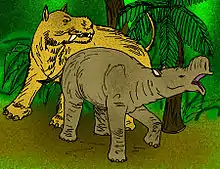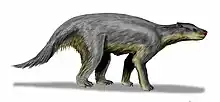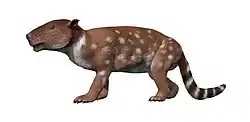| Hypercoryphodon Temporal range: Late Eocene, | |
|---|---|
 | |
| Hypercoryphodon thomsoni and the dinoceratan Gobiatherium major | |
| Scientific classification | |
| Domain: | Eukaryota |
| Kingdom: | Animalia |
| Phylum: | Chordata |
| Class: | Mammalia |
| Order: | †Pantodonta |
| Family: | †Coryphodontidae |
| Genus: | †Hypercoryphodon Osborn & Granger, 1932[1] |
| Species: | †H. thomsoni |
| Binomial name | |
| †Hypercoryphodon thomsoni | |
Hypercoryphodon is an extinct genus of rhinoceros-sized pantodont native to Late Eocene Mongolia, and was very similar to its ancestor, Coryphodon. Described from a skull, Hypercoryphodon is a quadrupedal hippopotamus-like herbivore that may have been able to adapt its feeding to suit different situations. It is thought to have possibly lived in wetland to forest ecosystems that it might have shared with other herbivores such as dinoceratans like Gobiatherium.[2]
References
- ↑ Hypercoryphodon in the Paleobiology Database. Retrieved July 2013.
- ↑ Osborn, H. F., & Granger, W. (1932). Coryphodonts and uintatheres from the Mongolian Expedition of 1930. American Museum Novitates; no. 552.
External links
- Mongolia at Okapiland
This article is issued from Wikipedia. The text is licensed under Creative Commons - Attribution - Sharealike. Additional terms may apply for the media files.

